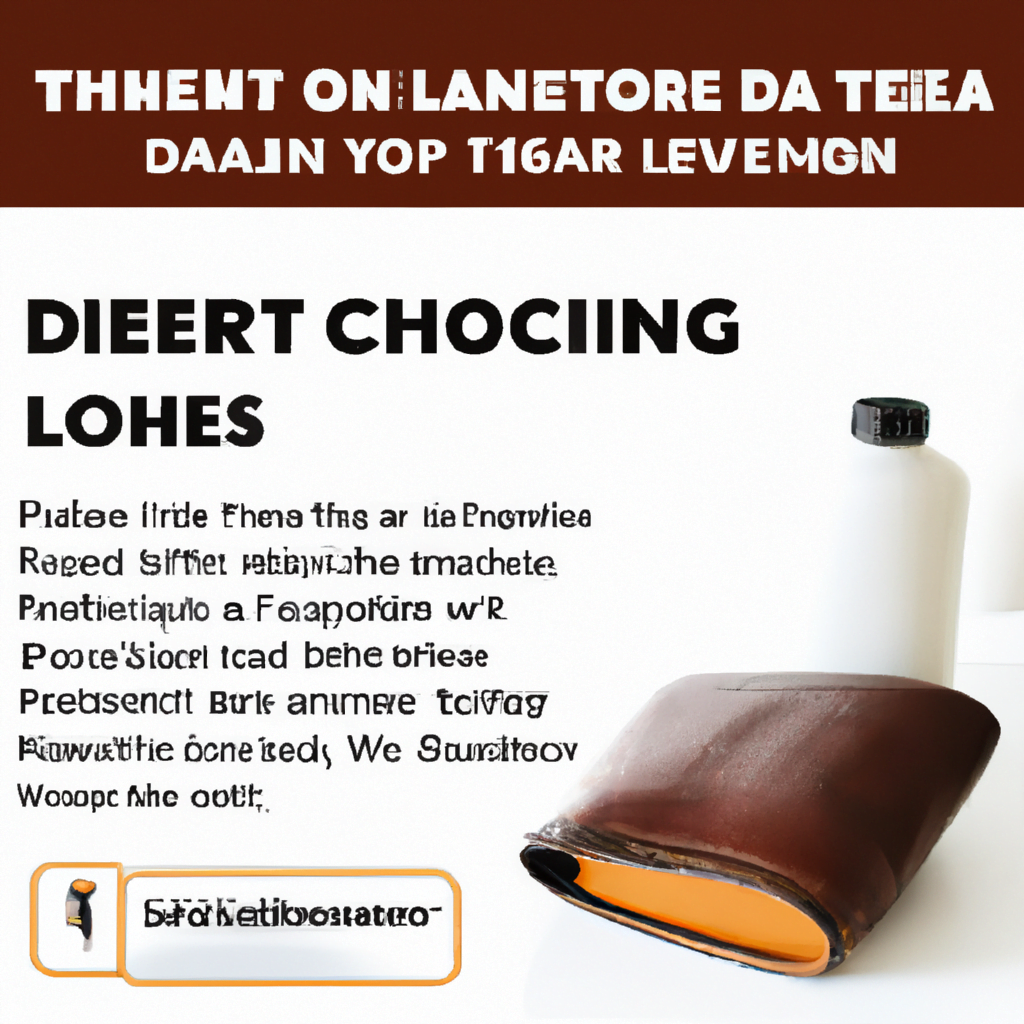Harnessing the richness of natural ingredients, ‘DIY Leather Cleaner’ is designed to provide you with an easy-to-follow recipe for your very own leather cleaner. Made with items commonly found around your home, this foolproof formula is designed to offer a durable shine to your cherished leather pieces – whether it’s your favorite boots, your sleek leather jacket, or the comfy leather sofa that graces your living room. Who knew preserving the appeal of your precious leather commodities could be such a breeze? So, brace yourself for a memorable DIY journey, where every step gets interestingly simpler, and the results beautifully potent.
Understanding Leather Types
Leather, an extremely durable and flexible material, is made from the processed skin of various animals. The quality and characteristics of this material vary greatly depending on the type of animal and the specific processing methods used to create it.
An Overview of Leather Types
There are various types of leather, each having specific properties that make them ideal for different uses. Some of the most common types of leather include full grain, top grain, genuine or corrected grain, and bonded leather. Full grain is considered the highest quality, featuring the entire grain and providing high durability and breathability. Top grain is also quite high-quality, but has had the top layer sanded away for a smoother feel. Genuine leather, on the other hand, is made from less high-quality parts of the hide, while bonded leather is created from scraps that have been bonded together with adhesives.
Types of Leather Used in Different Products
Different types of leather are used for making different types of products. Full grain and top grain leathers, for instance, are often used for high-quality furniture and luggage due to their durability. Genuine and bonded leathers, while less expensive and somewhat less durable, are frequently used in crafting clothing, shoes, and small accessories like wallets because they are more affordable and lighter in weight.
The Necessity of Cleaning Leather
Maintaining and cleaning your leather products correctly can enhance their longevity and preserve their quality.
Preserving Leather Quality
Leather is a natural product that requires regular maintenance to retain its strength and beauty. Without regular cleaning, leather can become dull, brittle, and prone to cracking.
Preventing Leather Damage
In addition to preserving quality, one of the main reasons for cleaning leather is to prevent damage. This can include anything from stains and discoloration to cracks and tears, all of which can significantly affect the material’s appearance and lifespan.
The Role of Regular Cleaning
Regular cleaning plays a key role in maintaining the longevity of leather. It helps remove dirt, oil, and grime that can accumulate over time and lead to permanent stains or damage. Moreover, it ensures the leather maintains its original color and texture.

Commercial Leather Cleaner Vs. DIY Leather Cleaner
When it comes to cleaning leather, both commercial products and homemade cleaners can be used.
Comparison of Ingredients
Commercial leather cleaners often contain a mix of chemicals designed to clean and condition the leather. However, these can sometimes be harsh and potentially damaging to the leather. DIY cleaners, on the other hand, can include simple and natural ingredients like vinegar and olive oil, which are less likely to cause harm.
Analyzing Cost-Effectiveness
Commercial cleaners can sometimes be quite expensive, particularly premium brands designed for specific types of leather. Conversely, DIY leather cleaners can often be made for just pennies on the dollar, using accessible household items.
Exploring Convenience and Accessibility
While commercial cleaners can typically be purchased in any store selling cleaning supplies, homemade cleaners require you to source and mix the ingredients yourself. However, since most DIY cleaner recipes contain common household ingredients, you may already have everything you need on hand.
Ingredients of a DIY Leather Cleaner
Common Household Items
Vinegar and olive oil are two common household items often used in DIY leather cleaners. Vinegar acts as a natural cleaning agent, while olive oil conditions the leather, keeping it supple.
Natural and Eco-friendly Ingredients
Other natural and eco-friendly ingredients can also be used in creating a homemade leather cleaner. These could include lemon juice, a natural bleaching agent for removing tougher stains, and essential oils that add a pleasant fragrance to the cleaner.
Ingredients to Avoid
When making a DIY leather cleaner, it’s best to avoid using any ingredients that may damage the leather. This would include anything abrasive or highly acidic, as well as any oils that could potentially stain the leather, such as dark cooking oils.

Preparing Homemade Leather Cleaner
Step-by-Step Preparation Guide
To create a DIY leather cleaner, first, gather your ingredients. A basic recipe would include one part vinegar to two parts olive oil. Simply mix these together in a spray bottle, and shake well before each use.
Safety Measures While Preparing
When preparing your DIY leather cleaner, make sure you are in a well-ventilated area. While the ingredients are generally safe, vinegar can have a strong smell that may cause discomfort. Also, be sure to use a clean and sterilized container for the mixture to ensure there are no contaminants that could potentially harm your leather products.
Applying DIY Leather Cleaner
Methods of Application
Once you have prepared your DIY leather cleaner, the application is quite simple. Just spray the cleaner lightly onto a soft cloth, then gently wipe it onto the leather surface. It’s always best to do a patch test on a hidden area first to ensure that the cleaner will not harm your leather.
Safe Application Practices
It’s also necessary to use safe practices when applying your DIY cleaner. Avoid applying too much pressure as you wipe the cleaner onto the leather, which can potentially cause scratches or other damage.
Frequency of Cleaning
The frequency of cleaning will depend on the type and usage of your leather product. However, as a general guideline, it’s recommended to clean your leather items once every three months or so for optimal maintenance.
Handling Different Leather Stains
Oil and Grease Stains
For oil or grease stains, it’s best to blot the stain with a clean cloth as soon as possible to absorb as much of the oil as you can. If the stain persists, you can try lightly dampening the area with your DIY cleaner, then blotting it dry.
Ink Stains
Ink stains can be particularly tricky to remove. Dabbing the stain with a cotton swab soaked in rubbing alcohol can sometimes lift the ink. However, it’s crucial to perform a patch test first as alcohol can sometimes cause discoloration.
Water Stains
For water stains, the best approach is often to lightly dampen the entire area surrounding the stain with your DIY cleaner, then allow it to dry naturally. This can help prevent a ring from forming around the stain.
Aftercare and Maintenance of Leather
Leather Conditioning
In addition to regular cleaning, leather also needs to be conditioned to keep it supple and prevent cracking. This can be done using a commercial leather conditioner or a DIY alternative like olive oil or baby oil.
General Leather Care Tips
Beyond cleaning and conditioning, general care of leather includes things like avoiding prolonged exposure to sunlight, which can cause fading, and avoiding contact with sharp objects that could scratch or pierce the leather.
Common Mistakes to Avoid
Mistakes during cleaning preparation
Mistakes during preparation can include not shaking the cleaner before each use to ensure the ingredients are combined properly, or using a dirty or contaminated container to mix your cleaner.
Mistakes during cleaning application
During application, it’s important to avoid using an excess amount of cleaner, as well as applying too much pressure. It’s also critical to perform a patch test on an unseen area to ensure the cleaner won’t cause any damage or discoloration.
Post-cleaning Mistakes
After cleaning, allow the leather to dry naturally instead of using a heat source, which can cause cracking. Also, make sure the leather is completely dry before you use or store it to prevent potential mold or mildew.
Benefits of Using DIY Leather Cleaner
Cost Efficiency
Using a DIY leather cleaner can be extremely cost-effective, as it can usually be made from common household items at a fraction of the cost of a commercial cleaner.
Environmental Impact
DIY leather cleaners can also have a lower environmental impact, as they typically use natural, eco-friendly ingredients and involve minimal packaging.
Control over Cleaning Process
Finally, making your own leather cleaner provides control over the cleaning process. This means you can modify the ingredients to better suit your specific leather item, and you can clean as often as you deem necessary without worrying about cost.
